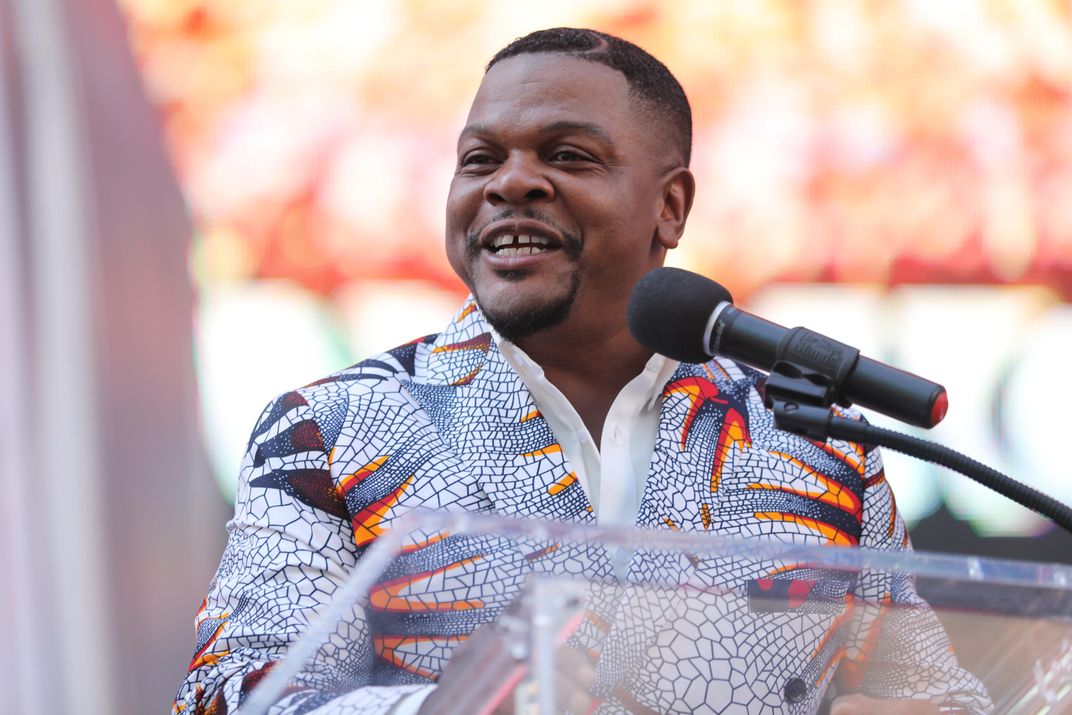A New Statue in Times Square Challenges the Symbolism of Confederate Monuments
The work by artist Kehinde Wiley will soon be moved to Richmond, Virginia, not far from a street lined with controversial Civil War memorials
/https://tf-cmsv2-smithsonianmag-media.s3.amazonaws.com/filer/8b/df/8bdf3333-62e3-47bd-9e89-f80524e7b4af/gettyimages-1177505827.jpg)
Late last month, a towering statue of a man on horseback, his body twisted backward as though in the heat of battle, was unveiled in Times Square. At first glance, the statue might seem an odd addition to the bright lights and bustle of New York’s flashiest hub, an antiquated relic of a time when prominent men were memorialized with equestrian monuments. But a closer look reveals a decidedly modern artwork. The statue’s rider is an African-American man, his hair pulled into a knot atop his head. On his feet are a pair of Nikes.
As Reggie Ugwu reports for the New York Times, the monument is the latest creation by Kehinde Wiley, who is perhaps best known for painting the official portrait of President Barack Obama that hangs in the Smithsonian's National Portrait Gallery. Though the statue, titled “Rumors of War,” made its debut in Times Square, it will soon head to Richmond, Virginia—where it will serve as a direct challenge to the Confederate monuments that line one of the city’s famed thoroughfares.
“Rumors of War,” in fact, directly references a statue of the Confederate general J.E.B. Stuart on Richmond’s Monument Avenue, recently re-christened Arthur Ashe Boulevard in honor of the African-American tennis great. But the street is still home to multiple Confederate statues; the first one, which pays tribute to Robert E. Lee, was erected in 1890 amid a “national wave of sentimental monument-building on the 25th anniversary of the end of the Civil War,” according to Michael J. Lewis of the Wall Street Journal. A later statue of Confederate president Jefferson Davis was “widely understood to be a symbol of defiant racism, the architectural equivalent of a burning cross,” Lewis adds.
Wiley saw these monuments during a 2016 trip to Richmond for an exhibition of his work at the Virginia Museum of Fine Arts. He says he was drawn to the Stuart statue because “of the gestural feel of the horse,” according to Philip Kennicott of the Washington Post. But of course, “Rumors of War” is pointedly symbolic, infusing its rider with a dignity and regality that lions of the Confederacy sought to destroy.
“Today,” the artist said during the New York unveiling, per Ugwu of the Times, “we say yes to something that looks like us. We say yes to inclusivity. We say yes to broader notions of what it means to be an American.”

In some respects, “Rumors of War” is signature Wiley. He is known for his elaborate paintings of black men and women, which blend street culture with the stylistic traditions of European and American masters. His subjects, clad in hoodies and adorned with tattoos, reference such famed works as Jacques-Louis David's Bonaparte Crossing the Alps at Grand-Saint-Bernard and Rubens’ Philip II on Horseback.
But this is Wiley’s first public artwork, rendered not with paint, but in bronze. “What I do in my own work here with regards to sculpture is to allow the city to be the backdrop, to allow a moving and constantly changing America to be the context in which we see this young man riding a massive horse in the middle of Times Square, soon to be in the middle of Virginia,” the artist tells the Associated Press.
Once it moves to its new home, “Rumors of War” will stand near the entrance to the Virginia Museum of Fine Arts, not far from the Confederate monument that inspired it. The museum commissioned the statue after Wiley proposed the artwork to Alex Nyerges, the institution’s director.
“It was the best idea I had ever heard,” Nyerges tells Kennicott.
Like other locations across America, Richmond is “locked in a struggle over what to do with [Confederate] memorials,” Nyerges adds. With “Rumors of War,” he says, “we change the whole conversation.”